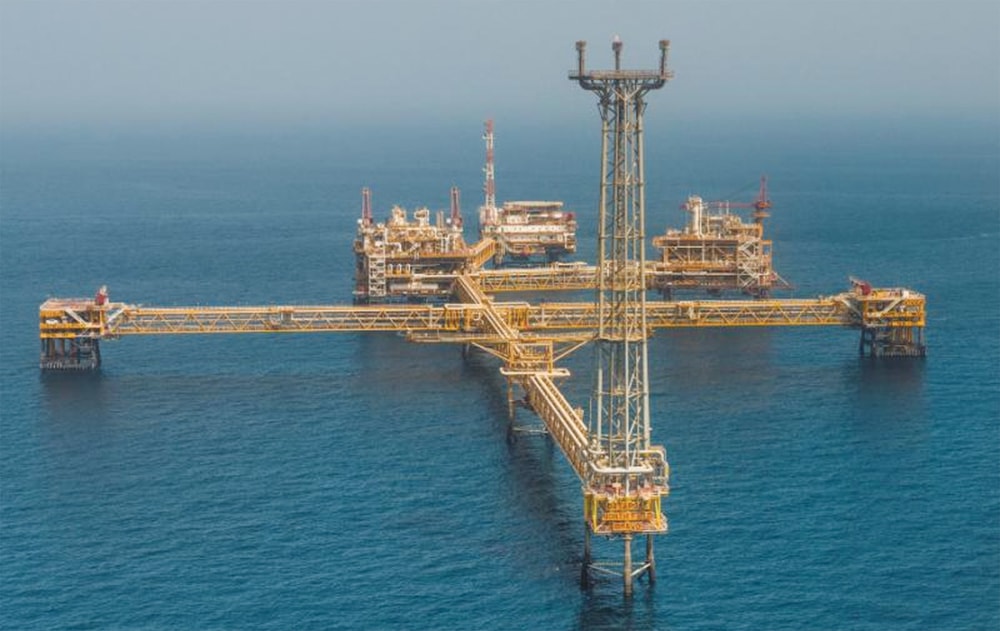Qatar Petroleum has taken the final investment decisions for developing the North Field East Project (NFE), the world’s largest LNG project.
Qatar Petroleum (QP) recently announced two major contracts for the NFE Project.
First was the signing of the project’s key onshore engineering, procurement and construction (EPC) contract. The main scope of the contract is the construction of four mega LNG trains each with a capacity of 8 MMTPA, with associated facilities for gas treatment, natural gas liquids recovery, and helium extraction and refining within Ras Laffan Industrial City (RLIC).
In addition to LNG, the NFE project will produce condensate, LPG, ethane, sulfur and helium. It is expected to start production in Q4 2025 with approximately 1.4 mn barrels oil equivalent per day.
 At the signing ceremony, HE Al Kaabi said: ‘The execution of this EPC contract marks the commencement of the construction of the North Field East LNG Project, and is a significant landmark in Qatar Petroleum’s strategic growth journey in a sustainable manner. The total cost of the NFE project will be USD28.75 bn, making it one of the energy industry’s largest investments in the past few years, in addition to being the largest LNG capacity addition ever, and the most competitive LNG project in the world. This project will generate substantial revenues for the State of Qatar and will have significant benefits to all sectors of the Qatari economy during the construction phase and beyond.’
At the signing ceremony, HE Al Kaabi said: ‘The execution of this EPC contract marks the commencement of the construction of the North Field East LNG Project, and is a significant landmark in Qatar Petroleum’s strategic growth journey in a sustainable manner. The total cost of the NFE project will be USD28.75 bn, making it one of the energy industry’s largest investments in the past few years, in addition to being the largest LNG capacity addition ever, and the most competitive LNG project in the world. This project will generate substantial revenues for the State of Qatar and will have significant benefits to all sectors of the Qatari economy during the construction phase and beyond.’
HE Al Kaabi added the project comes at a time when the world is still feeling the impact of the pandemic and related depressed economies, and is a demonstration of Qatar’s commitment to supply the world with clean energy.
He also stated it encompasses solid environmental investments in support of QP’s strong commitment to achieve the highest environmental standards, and to provide a credible solution in the low-carbon energy transition.
QP have also awarded a major EPC contract worth more than USD2 bn to Samsung C&T Corporation for the expansion of the LNG storage and loading facilities located within RLIC.
According to HE Al Kaabi: ‘This contract provides for the expansion of existing infrastructure required to ensure the safe loading and on-time delivery of our LNG cargoes to our international customers across the globe. Its scope includes three LNG tanks and three LNG loading berths for NFE, and options for two LNG tanks and one LNG berth for NFS project, and all associated pipes, lines and loading lines.’
Both contracts are the result of front-end engineering and design work that began in early 2018.
Environmental concerns
Qatar Petroleum pays particular attention to environmental standards by employing high-efficiency designs and the best industry technologies to reduce gas and effluents emissions.
One of the most important environmental elements of the NFE project is its CO2 capture and sequestration (CCS) system that will be integrated within the wider CCS scheme at Ras Laffan Industrial City. Once fully operational, it will be the largest of its kind in terms of capacity in the LNG industry, and one of the largest ever in the world.
As well as the CCS scheme, the NFE project will have other elements that provide positive environmental activities, including:
• A significant portion of the project’s electrical power needs will be provided from Qatar’s national power grid. However, QP is also in the process of obtaining power from the 800 megawatt solar power plant currently under construction in Al Kharsaah, alongside a further 800 megawatts of solar power soon, as part of QP’s plans to have a solar power portfolio of more than 4,000 megawatts by 2030.
• A ‘jetty boil-off gas’ recovery system will help reduce greenhouse gas emissions by around a further 1 mn tons per annum (MMTPA) of CO2 equivalent.
• The project will conserve 10.7 mn cubic metres of water per annum by recovering 75% of the plant’s tertiary water.
• NOx emissions will be reduced by 40% through the application of enhanced Dry Low NOx technology.
 The NFE project is the first phase of LNG expansion in Qatar. The second phase, the North Field South Project (NFS), will further increase LNG production capacity from 110 MMTPA to 126 MMTPA.
The NFE project is the first phase of LNG expansion in Qatar. The second phase, the North Field South Project (NFS), will further increase LNG production capacity from 110 MMTPA to 126 MMTPA.
Production is expected to start in 2027, with the project including two additional mega LNG trains, with a capacity of 8 MMTPA each, and associated offshore and onshore facilities. The NFS project commenced further to QP’s successful continuing onshore appraisal activities in the North Field and targets the monetisation of gas from the field’s southern sector. As appraisal continues, QP is eyeing even further LNG capacity expansion beyond 126 MMTPA.
About the North Field
In 1971, exploration engineers discovered natural gas off Qatar’s northeast coast, without realising just how important the find was. However, over the next 14 years, 15 appraisal wells had been drilled, and it was established that the North Field was the largest non-associated natural gas field in the world, with recoverable reserves of more than 900 trillion standard cubic feet (tscf) – approximately 10% of the world’s known reserves. This find makes Qatar the third largest holder of proven gas reserves in the world, after Russia and Iran. The North Field will supply gas to fulfil multiple large-scale renewable gas sales contracts for many decades to come.
The North Field covers an area of more than 6,000 sq km, approximately half the land area of the State of Qatar. Commercial exploration of North Field gas resources started in late 1991 with initial gas production from Phase I (Alpha Project). A moratorium was imposed in 2005 as the country wanted to study the impact on the reservoir from the rapid increase in output – this was lifted in 2017 following the announcement by QP in July 2017 to increase production to 100 mn tons per annum by 2024.
This increase would be achieved by doubling the size of the new gas project in the southern sector of the North Field, which QP had announced just a few months previously. This will increase the North Field’s production of natural gas, condensate and other associated products by one mn barrels of oil equivalent per day. Qatargas, the world’s largest LNG company, are executing the project on behalf of QP.
The development of this major natural resource has been a significant factor in Qatar’s economic growth. The gas produced from this giant field is processed to produce LNG, gas-to-liquids (GTL), natural gas liquids (NGL), and other gas-related industries, as well as pipeline gas for export.
Awards already made include:
• The Front End Engineering and Design (FEED) of the onshore facilities of the NFE project, to produce an additional 23 MMTPA of LNG, to Chiyoda Corporation of Japan.
• The ‘Detailed Design’ contract for eight NFE project offshore jackets, and the FEED contract for offshore pipelines and topsides facilities to McDermott Middle East Inc.
• Onshore site preparation for four LNG trains at RLIC to Consolidated Contractors Company and Teyseer Trading and Contracting Company.
• Contracts for eight offshore jackup drilling rigs, six to Gulf Drilling International and two to Northern Offshore Drilling Operations Limited.
Author: Sarah Palmer
This feature is from Marhaba – Issue 80 Spring/Summer 2021.
Copyright © Marhaba Information Guide. Reproduction of material from Marhaba Information Guide’s book or website without written permission is strictly prohibited. Using Marhaba Information Guide’s material without authorisation constitutes as plagiarism as well as copyright infringement.





